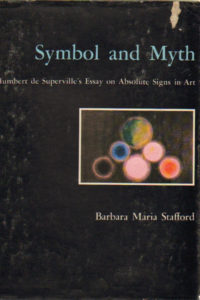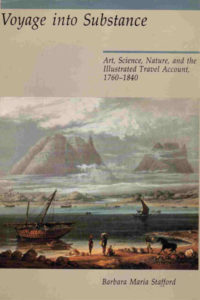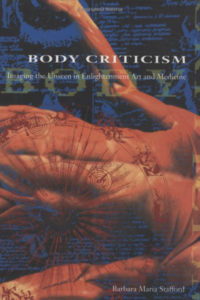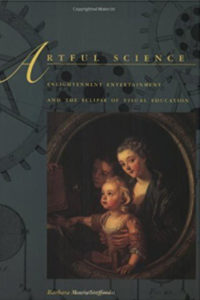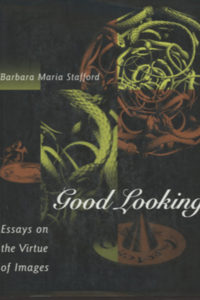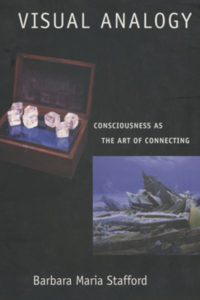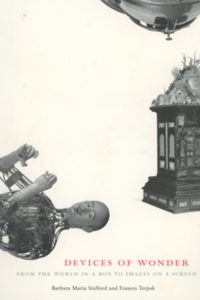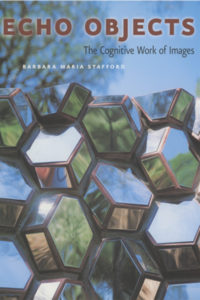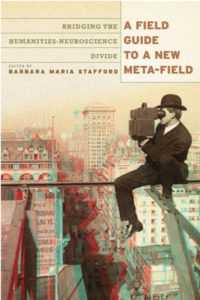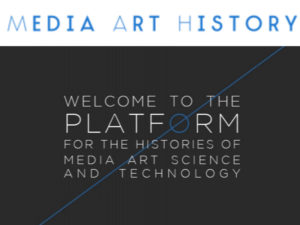Writer, Author, Speaker
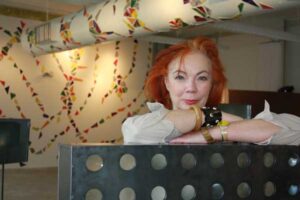 Barbara Maria Stafford is an independent writer, curator and speaker. Her work has consistently explored the intersections between the visual arts and the physical and biological sciences from the early modern to the contemporary era. Her current research charts the revolutionary ways the neurosciences are changing our views of the human and animal sensorium, shaping our fundamental assumptions about perception, sensation, emotion, mental imagery, and subjectivity.
Barbara Maria Stafford is an independent writer, curator and speaker. Her work has consistently explored the intersections between the visual arts and the physical and biological sciences from the early modern to the contemporary era. Her current research charts the revolutionary ways the neurosciences are changing our views of the human and animal sensorium, shaping our fundamental assumptions about perception, sensation, emotion, mental imagery, and subjectivity.
NEW ESSAY IN MUSEUM CONFIGURATIONS
E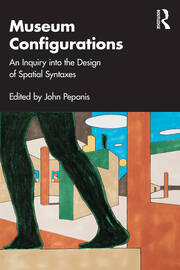 ssay in Chapter 10 by Barabara Maria Stafford: "Postscript: What more can museum architecture do?"
ssay in Chapter 10 by Barabara Maria Stafford: "Postscript: What more can museum architecture do?"
Museum Configurations demonstrates how museum space functions cognitively and communicatively and questions whether it can be designed to provide a rich embodied experience, situating displays and their public in felicitous dialogue.
Including contributions from authors working in the disciplines of architecture, psychology, museum studies, history and the visual arts, this volume addresses an interdisciplinary audience. The analysis of a wealth of examples shows how the voices of architects, curators and exhibition designers enter into dialogue and invite visitors to make their own connections between physical, cognitive and affective space. Considering how the layout of museums facilitates movement and orientation so that visitors may devote their attention to displays, the book questions what kinds of visual attention characterizes museum experiences and how the design of museum space can support them. In the context of an often dematerialized, atomized, and dissipating contemporary culture, the book proposes that museums can function as shared space that supports enjoyment and learning without being overly didactic.
Museum Configurations focuses upon the functions and aims of the design of space. This makes the book particularly interesting to academics and students working in exhibition design and museum architecture, as well as to exhibition designers, curators, and architects.
Forthcoming Essay by Dr. Stafford
Writ large, this essay asks—within the framework of a Graduate Seminar—how might architects design museums according to Biourbanist principles? Further—continuing the challenge--how might exhibition areas, building exterior, and existing urban site be interwoven and art objects grow and decay, rather than merely being inserted inside increasingly vast and solipsistic structures? What new perception of space as softening atmospherics, rather than geometric diagrams, and urban construction as a type of sensual natural history, rather than parsing language, bring to evolving museum design thinking? Guiding examples past and present include practical as well as theoretical models from Leibniz to Arundhati Roy, Rococo ornamental ruin prints to Material Ecology Design, Kate Orff to Marco Casagrande.
“What is the role of the geometric intuition in how we understand cities? . . . All cities, the organic as well as the geometric are pervasively ordered by geometric intuition . . . so that neither the forms of the city nor their functioning can be understood without insight into their distinctive and pervasively emergent geometric forms”i [Bill Hillier]
“Thus we see that each living body has a dominant entelechy, which in the animal is the soul; but the limbs of this body are full of other living beings, plants, animals, each of which has its own entelechy, or its dominant soul.”ii [G.W. Leibniz]
From Architecture as a Form of Language to Architecture as Natural History
What prompted Gottfried Wilhelm Leibniz-- brilliant mathematician, inventor of algebraic logic, and Early-Modern philosopher of analogical thinking— to argue that rhizomatic roots could develop into branching veins or snake coils mutate into ropey intestines? Recently, during a brusque Midwest Spring, I understood how the idea that any seemingly inanimate chunk of matter—a stone or bark or a drop of urine-- might result in an infinity of monads and their organic bodies. And that these bodies should be considered intentional objects, that is, objects that have their own processes and competencies independent of, but conjoined with, the human. According to Leibniz’s prescient and ecophilic “Doctrine of Marks and Traces,” the entire history of the universe can be read [totally by God, aspectually by man] in the essence of individual substances whose “thisness” is determined by the sum of their qualitative properties.
Walking along a windy country road in April, I was struck by carapaced oak leaves, still bronzed f rom last Fall, that paused, jumped, and skittered across the pavement. The shivering activity of these dead formations—seemingly performing with intent—became most perceptible as they approached the curve in the road. At a distance of six feet, the viewer could not be certain whether she was looking at the fitful progress of an insect buffeted by the wind or a leaf gusting around a turn . At three feet from the bend, it was as if one were watching an equivocal creature struggling to become animate. Lifeless things appeared not only to change direction but form. Resisting labelling and easy distinguishability, their order or spatial arrangement was emergent, innate, entropic, yet visually intuitable.iii
Fascinated by this panorganicist drama of transformation leads me to ask how and when do we perceive any shift towards change: not just in beings but in concepts, theories, ideas, practices? Consider Space Syntax now. We seem to exist at a translational moment when ultra-or beyond- green architectural principles-- such as Biourbanism, “ Material Ecology” Design [i.e., “buildings that grow—and then melt away”]iv, Biotope Projects, v MIT’s “Mediated Matter Group” -- are beginning to unify their mandate to discover new ways to confront, not just redevelop, the existing environment. Simultaneously, ecologically –minded municipalities from Scandanavia, Holland, to Canada are building high-rises and, yes, even Museums. [ see Herzog & de Meuron’s Vancouver Art Gallery] from mass-timber as well as other self -generating materials. vi Bio-engineered foam, elastic membranes, microrganisms, spider silk are being invoked to foster whole -building recycling. Surely, Leibniz’s Natural History is due for a comeback.
This emergent movement derives from, among other things, the realization by increasing numbers of architects and designers that conventional concrete, steel, and glass construction methods—no matter for what type of structures-- are terrible contributors to the emission of greenhouse gases. Responsible builders thus ”have no choice but to explore alternative materials, including wood and other bio-based products [Mycelium—networks of fungi—and straw, for example, can be used as insulation.]” vii And indeed the latter was used this Fall in a Museum Studio Project: ”Beautiful Weakness: Softening the City.” But more about that in Part II.
The appetite for building in the ways that natural materials grow and decline---that is, making architecture from the unlikely likes of apple skins, oyster shells, and even fallen leaves-- addresses the precarious realities of lived space, the atmospheric existential space not capturable with isovists [ i.e.,measurable volumes of space from a given point of space]. How does one diagram, or even discover, let alone construct, coherent points of view inside our shambling, frequently make-shift urban spaces—far exceeding Colin Rowe’s spreading “collage cities”-- involving the planar collaging and superimposing of portions of heterogenous plans -- a practice going back to Piranesi ? viii Instead, Rowe’s game play-- forming Modernist collections of diverse sections composed of formal shapes-- we are surrounded by sites without even the possibility of coherence. How adequate is the formality of networked geometric diagrams, the concept of urban centers or categorizable peripheries, to the sensory and perceptual mismatches of multiudinous scales and overloaded global megacities—cities less mindfully designed than springing up like weeds or going to ground?
Consider Arundhati Roy’s atmospheric and textural evocation of South Delhi’s pathologies of space:
“The car floated like a steel bubble through streets wide and narrow, smooth and potholed, for more than two hours. They glided through dense forests of apartment buildings , past gigantic concrete amusement parks, bizarrely designed wedding halls and towering cement statues as high as skyscrapers, of Shiva in a cement leopard skin loin cloth with a cement cobra around his neck and a colossal Hanuman looming over a metro track . . . But when they took an exit road off, they saw the world underneath the flyover was an entirely different one—an unpaved, unlaned, unlit, unregulated, wild and dangerous one, in which buses, rickshaws, cycles, handcarts and pedestrians jostled for survival. One kind of world flew over another kind of world without troubling to stop and ask the time of day . . . The steel bubble floated on, past shanty towns and industrial swamps, where the air was a pale mauve haze, past railway tracks packed thick with trash and lined with slums . . . . “ix
Would Space Syntax’s analysis of point- spatial layouts help us discern integration [based on the normalized measure of distance from an originary space to all others in a system]-- in Roy’s sensory anthropological description of an unruly urban morphology? How to locate a discrete system of continuous patterns in buildings formed manifestly not from identical components ? Has the social logic of space and human [as well as non-human] activity not radically changed since the late twentieth century? Or do we need to figure out new relationships among the synthetic, the sensuous, the preexisting as well as a range of previously unimaginable interventions and fabrications yielding grotesque lands and ruined structures? Is easy navigation really the central question now in clotted spaces, like Roy’s Delhi or Lagos, or Mexico City, where the concept of “flow” verges on the inconceivable. The struggle to reclaim thus requires a new vocabulary as well as a new mentality. It’s not about the futile and repetitve attempts at replacement of desolation and wasteland visible in small towns as well as sizeable cities [ promised in the popular rhetoric of renovation] of more of the same, but the co-option of the shambling houses, spindly trees, mangled roots, leached earth, stripped and bulldozed ground , into a new kind of correlative practice and configurational thinking.
Kevin Lynch’s call to locate the perceptual form in urban environs might now draw inspiration, not from the social sciences, but from landscape architects, designers, and environmentalists. Think of Argentinian sculptor/architect Tomas Saraceno’s rooftop Cloud City—a reflective habitat composed of interconnected modules grouped from non-linear shapes— a floating nimbus topping the Metropolitan Museum of Art. The fusion of inner and outer spaces is even more spectacular in the Barcelona Cloud City: the cupola atop the Mirador Torres Glories where 113 cloud spaces act like water droplets condensing on a spider web of tensile cables creating a foggy atmosphere merging outside weather with inside ambient. Or consider Finnish architect Juhani Pallasma question: what does it mean to share the world with everything from silkworms to AI entities?
As we attempt to become post-Anthropocene, how might Space Syntax structure space, analyse layouts, and discover potential patterns in buildings based less on master plans and monument-buildings, but in the transformative conditions and relationships between sustainable materials and decaying objects. Think more of the analogy governing fallen leaf/ exoskeleton insect or that associating copper- clad museum facade with woven, spun, grown, dissolving or degradable exhibitions. Anthony Blatt’s and Jonathan Fain’s First Americans Museum [opened in 2021] in Oklahoma City unites building and interior exhibition space, making them components of a segment “of an immense circular mound , 1000 feet in diameter, which rises in a clockwise spiral to a promontory 90 feet above the river.” The massive glass arch-- centered in four curving pavilions situated tunnel-like below and tracking the trajectory of the sun and equinoxes-- literally collects the diverse work of 39 tribal nations into a shrine walled from local Masquabuck stone whose interior functions as a sky/earth biosphere.x Nor does it seem accidental, in terms of Zeitgeist, that the British Museum recently opened an innovative exhibition, ”The World of Stonehenge,” that speaks powerfully not only regarding past, but present, concerns about preserving our vanishing--and thus ever more sacred, landscape. Like the solar-oriented First Americans Museum, the Mesolithic stone circle or ”henge” refers to a primal ditch dug into the chalk top soil. The dark Sainsbury Gallery is numinously lit by a window at the East End allowing the primal traces and fragmentary exhibits of horn and flint, metal knives and tools, and mouldering skeletons to emerge from flickering shadow into the cyclical sunlight developing as the visitor moves through time and space. The weathered installation, Seahenge, brings these Norfolk Coastal ruins indoors--eroded wooden pillars evoking the look and feeling of a great barrow. These valiant stubs blend conceptually as well as visually with the sarsen bluestones looming above Salisbury Plain.
II. Standing on the Verge: The Case of the Museum
“I think of life as a unity. This includes mountains, mice, rocks, trees, women and men. It’s all one big lump of clay.” xi [Ruth Duckworth]
“We need buildings and infrastructure that can withstand extreme conditions, so the search for resilience cannot be approached in terms of poetics alone.” [John Peponis]xii
If connecting heaven and earth and the great wheel of the seasons is at the core of both the British Museum Stonehenge exhibition and the construction of a situated First Americans Museum in Oklahoma City, they remain buildings and holdings that approach, but do not cross, the curve in the road. Both these deeply -willed combinatoric structures-- as well as Selldorf Architects 2014 addition to Venturi, Scott, Brown Associates San Diego Contemporary Art Museum [1996]—with its spectacular gathering of coastal setting into the La Jolla gallery-still do not arrive at integration. That is, they do not arrive at a coherent order merging structural fabric with the order and material of its contents.xiii Nonetheless, here and elsewhere, we are starting to see more than just an implicit desire to diminish the distinguishability between exterior and interior, site from contents, nature from culture, thus taking the measure of spatially arranged things beyond contrasts of symmetry and asymmetry.
True, It’s been a long time since the museum was a House of the Muses. Yet, as the recent Julie Mehrertu mid-career survey at the High Museum clearly demonstrated, museum goers have wearied of ever-more colossal canvasses located in the vaster galleries needed to hang them or, conversely, of vaster galleries which then require colossal objects to fill them.xiv Ironically, both the claustrophobic, bleak rectangular rooms and the vanishing tops of huge paintings reduce the viewer to consulting brief, unsatisfactory wall text and to guessing about the perspectively disappearing marks and traces floating out of sight .
So it was in the Fall of 2021-- in [Bill Hillier-trained] John Peponis’s Graduate Studio in Architecture and Design at the renamed Georgia Tech College of Design—that I proposed an integrative topic. In retrospect, one could say the idea was premature, early days for the conceptualization of a buildable, unified Biourbanist Museum, modest in scale, liveable, renewable. Worse: how could this approach relate, if at all, to the geometries of Space Syntax? Five students thought it worth giving a try. Why not attempt to design beyond the curve—recalling historically, for one, how Rococo French, German, and English print makers envisioned inhabitable ornaments composed of architectural fragments: overturned cornices, broken arches, eroding columns housing people as well as an encroaching landscape. Similarly, the marvelous Natural History illustrations arising from the eighteenth-century's fascination with geology, geography, crystallography, microscopy opened up worlds relating the inorganic and organic dimensions.xv Perhaps one could even extend Colin Rowe’s horizontal notion of a Collage City to reimagine Piranesi’s collection of shapes consisting of information-ladened, if overgrown, debris—not as lapidary mosaics or flat maps, but as a single growing and decaying entity. Think of them as embodying a New Ornamentalism embracing a conjoined and evolving contemporary morphology. xvi
The Studio as a whole was instructed to approach the problem of museum design [within a crowded city setting such as Atlanta] as a case study in which the architecture of the building and the internal space of the galleries worked in concert, not athwart, of one another. Students were explicitly asked not to design neutral boxes that presumably allowed maximum flexibility for curators given to conventional “hangs.” Within that larger purposive framework there were five notable tracks, each separately curated and defined.xvii I like to think, our group fell within that larger rubric while extending and inflecting the general theme with a Biourbanist slant. So what is Biourbanism and its ultra-eco-minded ilk still seeking an overarching name and building agenda? Its practitioners agree that it centrally involves architecture, design, ecology plus a broad spectrum of engineering and interconnected social sciences with an emphasis on sustainable models, intricacies of restoration-through-growth, the fusion of architecture with landscape. The latter, collapsed into “scape,” has the goal of healing wounded environments and delicate or blemished habitats. This intrarelational practice coordinates well with novelist Mieko Kawakami's notion of a devastated beauty beyond the perfectionism of a symmetrically contoured physiognomy.
Landscape architect Kate Orff's motto is " building with nature, not just in nature. She means by this: "greening" the watery infrastructure versus "graying" it with concrete dams, dikes, seawalls. xviii The “Beautiful Weakness” cohort sought inspiration from the innovative projects coming from her New York-based firm, prophetically named Scape. Not only is she reanimating the Staten Island coastline with the shattered remains of shellfish, she is leading an interdiscipinary “participatory design" group closer to home. An ongoing endeavor in Atlanta is dedicated to remaking/returning the degraded Chattahoochee Riverlands by rejoining urban, suburban, and rural Georgia so that socially and topographically diverse communities are only pathways apart.
The Finnish architect, Marco Casagrande, imagines a different kind of Biourbanism. An innovative experimentalist with trees and forests, he challenges the artifices of Modernity with his "Third Generation City Project.” xix Arguing that, given the realities of the dismantled city of the future [when, he predicts, all artificial constructions will have been obliterated by an uncontrolled environment], how do we design with nature on top, as it were?
Unlike Orff, he accepts nature as primeval and enduring: victorious to the last despite our scarring predations. Yet in what sort of dwellings shall humans live? The answer lies in Casagrande’s “tools”: the eroding, fragmenting powers of living nature itself; it's ability to destroy as well as regrow --but otherwise, not discretely, but combinatorially-- the most monolithic of artificial structures. More eponymous enclosure than home, consider the reweavings of his spidery-netted Cicada House or the vined and weedy rockeries of the Ruin Academy, sinking away into a subterranean kiva. In one way or another, many of his projects are burrowings into, or churnings of, the ubiquitous faux-marble or "glassy "skin" of the twenty-first century skyscraper.
If anything, Casagrande’s forward-looking designs resemble the inhabitable grotesques of the Rococo era ornamentalists: shell fountains, overgrown grottoes, decaying huts—but without the enchantments of the Picturesque. Similarly fragmentary, but no longer suggestive of a missing, greater architectural whole, Casagrande’s scapes are made of sterner, post- climate change stuff. Unlike the eighteenth-century's webbed cartouche, garlanded arabesque, or rank and reedy grotesque, Casagrande’s mastery is less botanical and more lithic. Perhaps Piranesi’s etched Pianti— those amazing macro-mosaic inlays of subsiding monuments, cracked pediments incomplete tables and indices, snatches of scenery, glimpses of truncated statuary, broken lapidary inscriptions, torn maps—best capture the spatial challenge of “beautiful weakness,” shadowing both our fragile past and present. Yet Piranesi could still place these existential as well as material gaps and gapings side by side for the viewer to stitch together. Those were the Enlightenment’s foundational lesions. How can today’s architecture address ours? In the end, Casagrande's rooted configurations are perhaps not so different from Orff's underwater building of artificial reefs from battered oyster shells, plastic-entwined eelgrass, and wavy arcs of fraying rope.
Importantly, this is a different theoretical position from that taken by current ecocriticism. Significantly, it is not negatively based but affirmatively builds from the inner being—the related textures, materials, dynamics, and morphologies of the human and the inhuman alike. It is worth underlining again that this galaxy of blood, tissues, cells and transmogrified “things” --forests, seas, the structural richness of encyclopedic materials—belong to relatable systems of order and ordering and thus form the logical and aesthetic backbone to the projects proposed by Biourbanism writ large.
In what perhaps should be called a rising “movement,” architecture becomes loosened into rude landscape components and the urban landscape is repossessed of its former complex elements and animation. These principles can be applied to Museum design as well. Instead of gigantic convoluted buildings and airless, over-lit, ill-proportioned -to- contents galleries, students in this Studio project envisaged the tug of ropey substances, the ripple of flowing shapes, lanky columns as supple tree trunks, durable rock walls calligraphically inscribed with the marks of their history, shadows as natural chiaroscuro painting. And the building—resisting Narcissistic over-inflation—was not to be merely erected upon, but physically drawn into, the specific site. Works of art, too, must be more than a stunningly -contained afterthought [that is, displayed mercilessly, meaninglessly stretched out in relentless corridors of one unrelated thing after another, or crammed into rooms where lone objects sit wedged and isolated}. Like their vast and glittering enclosures, works of art need to go to ground, re-achieving their strangeness, their demonic joint status as one real presence situated within another.
Within this larger conceptual and design framework, let me state our inquiry bluntly: Are museums exempt from recent attempts at building a variety of structures that grow and decline? Can exhibitions similarly coalesce and then dissolve?xx The challenge for students was to formulate their projects according to Biourbanist principles, infusing both the building and the gallery space with the concept and the practice of recyclable construction. To cite the Call for Papers for a recent [non-architectural] conference: the intent was to come up with new “possibles,“ that is, neither repeat what already largely exists nor just draw out what is sitting around waiting to be confirmed.xxi In the semester time frame, our attempts at a buildable ensemble yielded instructive, bold, and enthusiastic, if, as yet, unrealizables.
Nonetheless, with the requisite disciplines in hand, the construction skills mastered, and the continuing intellectual, imperative, their time will come. Environmental Sculpture has already arrived. As architecture looks to other art forms [abandoning the solipsistic and singular monumental] --especially sculpture and new media—astonishing relationships between objects falling outside of established categories will increasingly occur. Paradoxically, many multisensory/ intrarelational/projective/ and electronic art installations prefer to be housed in what I call ”buildings with character“--that is, revealing their aging fabric and auratic energy [ delapidated desecularized churches, blotched limestone fortresses, intimate experimental galleries]-- rather than in Brutalist or self-assertive structures whether of poured concrete or travertine marble.
III: “Beautiful Weakness”: The Museum and the Softening of Urban Architecture
“Plants are just very slow animals.”xxii [J. C. Schultz]
In her novel, _Heaven [2009], Mieko Kawakami, coins the phrase “beautiful weakness" to evoke the fragilities of the human body. Far from being deformities, she believes they render their bearers special. The singular harelip, the drifting eye, the jolting limp, the author contends, is a kind of positive punctuation differentiating someone or individualizing something from the seeming solidity of the crowd. Rather than seeking the curative in the restoration of despised marred objects, she proposes we understand them as strange beginnings, unlooked-for opportunities ready to meld with other equally blurred configurations.xxiii
Analogously, it can be argued, the extruded detail, the striated ornament, the welt-like pattern soften and reveal the vulnerability lodged within a seemingly poreless structures. These interruptive architectural gestures and decorative tokens of underlying structural fragility are exquisite visual reminders of the beautiful weakness residing in all organic matter. Presenting a kind of impacted deviancy within the intact, self-sufficient “body” of building materials, these softenings facilitate a merger with their vulnerable site. The resulting composition anticipates regeneration, encapsulating recycling, and so developing what one might term an allegory of sustainability.
Earlier, Joyce Carol Oates in “ The Affliction,” adumbrated Kawakami’s relational insight between corporeal affliction and feeling-arousing objects: those lumpy things we assimilate into our life cycle like birthmarks or old surgical scars. Though intimate, these earthy growths or plant-like extrusions possess a reactive public agency in the external world. The future artist and anti-hero of Oates’ short story literally pulls out of his oozing flesh clotted “things,” that is, the rashy “swirls and arabesques” that he later “extends” by mixing them into bas-reliefs with modelling clay, oil, acrylics, strips of paper, cloth, dried thistles, flowers. Remarkably, these “strange, vivid, and dreamlike designs” --these material “things” --leave him with “ no Self where he stood.” Such patterned mixtures of “body excresences” compounded of “what might be termed neutral materials” fashion an outer “presence of a kind, that though inanimate, mimicked life.”xxiv
Oates’ narrator comments how, when placed on a flat surface or upended into three-dimensional forms, these fleshy fragments-- torn from a living substrate and comprising “something not to be named” --dry to “shell-like shapes, of startling colors, bronze, blood-rust, bruise-like hues of purple, orange-green, iridescent blue.” xxv This suggestive--even Leibnizian-- passage evokes fusive works of painting, sculpture, and architecture laboring to tie together the perceiving subject‘s sensing body with the dazzling varieties of ambient matter. I think that Oates, as well as Kawakami, struggle to define an atmospheric and textural aesthetic beyond measurement: one that shapes a new order of composition as well as of feeling.
Carl Dilcher felicitously tuned this sensual perception to his purpose in his Project on “Fortunate Decay.” His design consisted of a limbic intervention into pre-existing urban density savaged by builders run amok, vacant lots, and the symptoms of fading industrialization. His rethinking of actual site condition as integral to the museum specifically focussed on the potential of the rubbished ground , that is, constructing upward from the damaged originary substances. How might a museum “be grown”--i.e., extend, not sit-- on the stark realities of the surrounding soil to draw in city dwellers into a formerly unseen enclave?
Or, as Katelyn Dimopoulos asked:
“ We know that lumber comes from trees, but how does this incredible plant transform into this perfected, utopian state [an imbricated, reconfigured museum]? If the objects within the exhibit can help the viewer connect the pieces that build their urban environment, such as wood, glass , and metal, back to their origin, this can aid in the urgent need for greater respect and protection of our natural ecosystem. The objects command the viewer to connect to them in their own personal way, whether by triggering nostalgia or excitement, in order to nurture a form of Platonic love toward nature. We protect what we love. ” She continues that the subject she wishes to explore in her project is the development and nurturing of our unconscious connection to nature in a way that is not abrasive or disjointed. For example, an exhibit on climate change cannot simply provide information and the classic [ I.e., dogmatic, mandating] rhetoric we see every day, such as words like “urgent” or “action now.”
This realization that we literally become what we pay attention to corresponds nicely with sociologist and historian of biology Hannah Landecker’s fascination with the remains and industrialization of food. In early 20th century America, there was, she declares, “no such thing as waste. Pulps, mashes, skins and bones from slaugherhouses . . . all had a metabolic value, because these waste products still contained compounds that could be utilized.”xxvi Similarly, is the aspiration of Biourbanist architecture not also ”to take these things from the process of decay that they would normally go through and channel them in a new way into another organism . . . .[or, in the case of a building, into another structure by converting one form into another?”xxvii
Facing the practical problem of the remobilization of waste in all its meanings, students pondered the visual analogies uniting organic nature, the human body, and artificial objects: conjoined in their living and dead materialism, their transitional processes, their troubled pathologies. Mindful of ongoing reciprocal exchange, projects coalesced around the question of how something often considered weak or defective can be transformed into a strength—creating intersecting bonds between self and world. Architecturally, the inquiry revolved around the evident, but unintentional, “softening” of our cities-- as they erode, fall back into unimproved nature, or assail the once-proud high-rises clad in balding cement and acid-rain pocked steel. Specifically, how might this decades-long inheritance of Modernism and its discontents be converted from blight to growth?
Barrett Blaker aptly noted the inherent physical and philosophical difficulties of creating for such a subtle space that is not routinely discursive or predicated on clean geometries, untrammeled viewpoints, or clear-cut identities. This requires the architect to articulate a new ontology:
“A Museum for Objects aims to unearth and decompose the barriers of animacy and being placed between the human and more-than-human world. The site operates at the ambiguous intersection between ruination and assembly, perpetually breaking apart as it endlessly reconstructs itself. . . . (Fig. 1) Space is “opened by erosion and weathering of the existing structures before introducing a construction zone which uses mycelium bricks to build into these newly created spaces as an act of transformative reclamation.” (Fig. 2) Synchronously, the museum’s ruined fabric showcases “art objects relating to impermanence, incapacity, and ephemerality within an architectural environment of softened, broken, and opened structures undergoing decay. “ (Fig. 3) These intertwined spaces encourage the visitor to engage with their own objecthood. Landscape, building, exhibition areas operate as a hybrid bridging a never-ending construction/growth/decay site with the changing exhibits of a science museum. Viewers resonate with the total site as the entire assemblage builds, stalls, decays, and repeats in ebbs and flows.

Fig. 1: Site Plan

Fig. 2: Site Collage

Fig. 3: Large Section
So what might architecture add to space now? If creating a “configuration” meant for Bill Hillier trying to detect the “presence of cultural and social ideas in the spatial forms of buildings,” then, surely, the experience of our surroundings has become more immense with scientists exploring how other species, with very different means for seeing and hearing, experience the world otherwise from humans. xxviii I’d like to think Space Syntax can make the cognitive and structural leap beyond understanding pattern as “people configurations” to envisioning them as scaped configurations –embracing the animate and inanimate world. xxix Architecture would thus add to space [an extension without objects] not just the fact that space occurs never on an inert background. Rather, it would acknowledge that the background is vanishing as it becomes practically and theoretically foregrounded.
All the more reason to conclude with a defense of the actual, messy, imperfect Studio. Not least, because it offers a palpable physical space for experimentation, an optimal situation for hands-on as well as visionary exploration-- including the conjuring of in- betweening configurations that are not yet completely realizable. For where—and when else—does the prospective architect or designer have the opportunity to wrestle with pressing and provocative issues that have not been previously formulated or ladened with prior, institutionalized examples? If not now, when can the groping student and future architect or potentially daring designer engage with the risky determinants of our evolving existential understanding, that is, grapple with the not yet fully-grasped or conventionally-assessed buildable possibilities? In addition to the other performance demands made upon it, the Studio is thus also the reciprocal site for testing emergent empirical and cognitive practices, for picturing germinative ways of reasoning about how to construct with, and within, our ruined environment.
[I] Bill Hillier, “Studying Cities to Learn About Minds: Some Possible Implications of Space Syntax for Spatial Cognition,” in Environment and Planning B [Vol. 39, Issue I, February 1, 2012].
[II] Gottfried Wilhelm Leibniz,” ”Panorganicism and Idealism, ” Monadology 70, G VI 619/ AG 222, Stanford Encyclopedia of Philosophy. Also see: ”All of Nature is full of life,” Principles of Nature and Grace: 1: GVI 598/AG207.
[III] Hoon-Tae Park, ”Before Integration. A Critical Review of Integration,” {Paper: 2005, University College London, UK] . Note this interesting and revising review of the role of measure, measuring beyond symmetry/asymmetry In Space Syntax and the question of entropy.
[IV] “Ellie Austin, “Buildings That Grow—and Then Melt Away,” The Future of Everything: Cities and Real Estate, The Wall Street Journal, [April 14, 2022], R8.
[V] See the projects of the Viennese Architectural Firm, Ruediger Lanier and Partner [RLP]
[VI] Rebecca Mead, ”Transforming Trees into Skyscrapers, The New Yorker [April 25 and May 2, 2022], p. 52.
[VII] Ibid, pp. 54-55.
[VIII] Colin Rowe, Collage City [Cambridge, Mass. And London: MIT Press, 1978].
[IX] Arundhati Roy, The Ministry of Utmost Happiness [New York: Alfred A. Knopf, 2017], p. 415.
[X] James Pepper Berry, The Smithsonian Magazine [September 27, 2021].
[XI] Quote from Ruth Duckworth: Life as Unity, Exhibition Announcement [Smart Museum of Art, The University of Chicago, forthcoming Fall 2023]
[XII] In a private communication to me regarding the forthcoming volume edited by John Peponis: Museum Configurations: An Inquiry into the Design of Spatial Syntaxes.
[XIII] Hoon-Tae-Park, ” ”Before Integration: A Critical Review of Integation, Measuring in Space Syntax,” [London, UK: University College, 2005]
[XIV] Julie Mehretu, exhibition [Atlanta, GA: High Museum of Art, October 21, 2020-January 31, 2021].
[XV] Barbara Maria Stafford, Art, Science, Nature and the Illustrated Travel Account: 1760-1840 [Cambridge, Mass. and London: MIT Press, 1984].
[XVI] Colin Rowe, Collage City [Cambridge. Mass. and London: MIT Press, 1978].
[XVII] See John Peponis et. al, Museum Configurations: An Inquiry into the Design of Spatial Syntaxes [forthcoming]
[XVIII] Eric Klinenberg, ”Kate Orff: The Seas Are Rising. Could Oysters Help? The New Yorker, August 2, 2021, [e-edition]
[XIX] See ”Marco Casagrande/ Sandworm,” ArchDaily.
[XX] See Architect Neri Oxman, member of ”material ecology” research group at MIT Media Lab, specifically the Aguahoja Project, 2018, where pavillions were programmed to degrade when exposed to rainwater through hydrophilicity.
[XXI] Call for Proposals for 2nd Summit on New Media Art: Archiving, International Society for New Media Art [Barcelona Museum of Art, June 6-11, 2022.
[XXII] Quote cited in Richard Lea, ”In Search of Planetary Intelligence,” Review of James Bridle, Ways of Being in Wall Street Journal [June 18-19, 2022], C9.
[XXII] Mieko Kawakami, Heaven, trans. By Sam Bett and David Boyd [Europa Editions, 2021].
[XXIV] Joyce Carol Oates, ”The Affliction,” in The Collector of Hearts. New Tales of the Grotesque [New York: Dutton, 1998], pp. 158-161.
[XXV] Ibid., p. 161.
[XXVI] See Interview by Carl Gierstorfer, ”’The Early Bird Gets the Profit’ Comes Home to Roost,” Koepfe und Ideen 2022 [Wissenschaftskolleg zu Berlin/ Institute for Advanced Studies: Fellows 2021/2022], 61.
[XXVII] Ibid., 58-65.
[XXVIII] See, for one, Ed Yong, An Immense World: How Animal Senses Reveal the Hidden Realms Around Us [New York: Random House, 2022].
[XXIX] Bill Hillier, ”Space is the Machine. A Configurational Theory of Architecture,” Space Syntax, edition [London, UK, 2007].
All Books by dr. stafford
Recent Talks
Mellon Sawyer Seminar
"The Magical Sublime"
Brown Symposium 38: Art & Revolution
"Creation Unbound"
Announcements
Barbara Stafford Receives the MediaArtHistories Award
On November 7, 2015, Prof. Dr. Barbara Maria Stafford was honored in Montreal with the MediaArtHistories Award of the International conference series on the Histories of Media Art, Science and Technology. Stafford is one of the most renowned and innovative contemporary art historians.
Read More


ANNUAL MEETING OF THE COLLEGE ART ASSOCIATION: LOS ANGELES, FEBRUARY 21-24, 2018:
A Critical Conversation on Affect Theory, Neuroscience, and Art-Science Collaborations
Chaired by Professor Anna SigrÃdur Arnar this session brought together innovative scholars and artists for a critical conversation on alternate sources to the current ideas of vision, perception, sensation, mental imagery, and subjectivity. Barbara Stafford, recipient of the inaugural MediaArtHistories award in 2015, served as a discussant.
In the words of Professor Arnar:
"A catalyst for our conversation today is the pioneering research of Barbara Maria Stafford, who among many other honors over her long career, recently received the inaugural MediaArtHistories award for her contributions in the field of imaging arts, optical sciences, and performance technologies as well as its attendant discourses. As early as 1968 when she was at the Warburg Institute in London working with Sir Ernst Gombrich, she began her life-long investigation into the theories of perception and the diverse visual practices and critical languages developed to probe, articulate, and at times overturn such theories... From her early investigations into the philosophical, scientific and aesthetic debates on the visualization of knowledge, to her more recent work dedicated to bridging the divide between the humanities, neurosciences, and cognitive science, Stafford has offered compelling paradigms for interdisciplinary scholarship and creative collaboration."
Read full introduction here.
Publication Highlights

The Jewel Game: Gems, Fascination and the Neuroscience of Visual Attention
By Barbara Stafford
Each time our gaze strikes the surface of any material or substance, a small miracle occurs. That which was nothing before becomes something for a few moments, and then nothing again once our gaze is averted. Looking at jewels makes us aware that we are aware, integrating the mind with the body at a particular instant in time while simultaneously incorporating the nonhuman world into our innermost being.Â
Read Full Piece
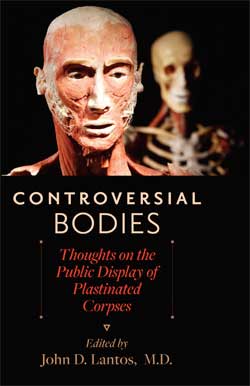
Controversial Bodies:Thoughts on the Public Display of Plastinated Corpses
"A rich survey of the issues provoked by the public display of plastinated corpses backed up by an impressive range of scholarship."—Alastair V. Campbell, author of The Body in Bioethics
Controversial, fascinating, disturbing, and often beautiful, plastinated human bodies—such as those found at Body Worlds exhibitions throughout the world—have gripped the public's imagination. These displays have been lauded as educational, sparked protests, and drawn millions of visitors. This book looks at the powerful sway these corpses hold over their living audiences everywhere.
